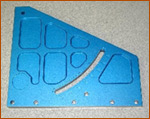Water jet cutting is best described as an accelerated erosion process. For this reason, water jet can cut or erode through virtually any material known, making it one of the most versatile machines available.
Alloys - Inconel, Hastalloy, Waspalloy, Titanium, Aluminum, Stainless etc.
 No heat effected zone or change in the molecular structure occurs in the alloy material. There is no distortion as seen with typical heat cutting methods. Generally, cutting with waterjet costs less than traditional machining or cutting methods. In many cases, no secondary removal of slag or damaged material is necessary, and minimal to no burring is seen. No heat effected zone or change in the molecular structure occurs in the alloy material. There is no distortion as seen with typical heat cutting methods. Generally, cutting with waterjet costs less than traditional machining or cutting methods. In many cases, no secondary removal of slag or damaged material is necessary, and minimal to no burring is seen.
Steels
 Waterjet is not always the most cost effective method to cut steels. As a rule, if the finished product is presently being cut using laser, plasma or oxyfuel, and no secondary work is needed to the part after being cut, it is unlikely waterjet will be an economical solution. However, as soon as any secondary work, closer tolerances or removal of the Heat Affected Zone (HAZ) is needed, waterjet is probably the solution. With the use of the WARD (Waterjet Abrasive Recycling Dispenser) companies are able to reduce their operating cost substantially, reducing the gap between laser and waterjet cutting. In many cases, waterjet now costs less than laser! Waterjet is not always the most cost effective method to cut steels. As a rule, if the finished product is presently being cut using laser, plasma or oxyfuel, and no secondary work is needed to the part after being cut, it is unlikely waterjet will be an economical solution. However, as soon as any secondary work, closer tolerances or removal of the Heat Affected Zone (HAZ) is needed, waterjet is probably the solution. With the use of the WARD (Waterjet Abrasive Recycling Dispenser) companies are able to reduce their operating cost substantially, reducing the gap between laser and waterjet cutting. In many cases, waterjet now costs less than laser!
Stone / Composites
  Many composites are very difficult to machine as the cutting tool tips 'gum' up and quickly becomes inefficient. Waterjet has no gumming at all and can leave a good clean surface requiring no additional work. Many composites are very difficult to machine as the cutting tool tips 'gum' up and quickly becomes inefficient. Waterjet has no gumming at all and can leave a good clean surface requiring no additional work.
 Plastics / Acrylics / Wood Plastics / Acrylics / Wood
It is possible to not only cut these materials effortlessly, but also drill start holes using specialized low pressure options available with certain systems.
Glass
 Intricate cutting and shaping of glass is easy with waterjet. The waterjet can generally drill all its own start holes, making it a highly versatile tool. Glass from 1/32" to 10" thick is no problem, even when laminated in multiple layers. Intricate cutting and shaping of glass is easy with waterjet. The waterjet can generally drill all its own start holes, making it a highly versatile tool. Glass from 1/32" to 10" thick is no problem, even when laminated in multiple layers.
Rubber
Depending on the darometer value, rubber can be cut with water only or with abrasive. Tests will quickly reveal what the best option is for your application.
Laminates
Waterjet, in most cases, does not see any difference between laminated materials - e.g. acrylic, aluminum, stainless and honeycomb section all laminated as one. Many aircraft parts consist of laminated materials where waterjet is the only solution.
Gaskets
By using waterjet for cutting gaskets, it is possible to automatically nest various sized and shaped gaskets on one sheet effortlessly. There is no longer any need for stacks of dies. Software will keep track of all remnant sheets allowing offcuts to be put back into inventory and used for smaller parts. Specialized software is available to track materials through the entire process.
Fiber glass
When cutting materials that are typically associated with hazardous fine airborne materials, waterjet is an ideal solution. Particles and materials removed are transported by the water away from the surface into the tank, eliminating this risk and hazard.
|



